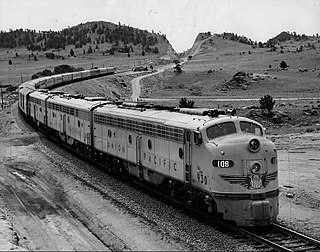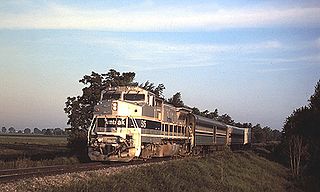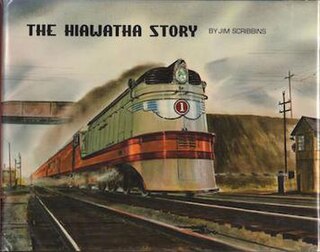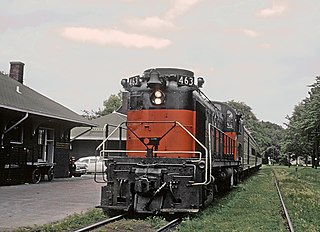
The Chicago, Milwaukee, St. Paul and Pacific Railroad (ACMStP&P), better known as the Milwaukee Road, was a Class I railroad that operated in the Midwest and Northwest of the United States from 1847 until 1986.

The Hiawatha, is an 86-mile (138 km) train route operated by Amtrak between Chicago, Illinois, and Milwaukee, Wisconsin. As of 2007, twelve to fourteen trains ran daily between Chicago and Milwaukee, making intermediate stops in Glenview, Illinois; Sturtevant, Wisconsin; and Milwaukee Mitchell International Airport. The line is partially supported by funding from the state governments of Wisconsin and Illinois. The line utilizes the CPKC Railway's C&M Subdivision and Metra's Milwaukee District North Line.

The City of Denver was a streamlined passenger train operated by the Union Pacific Railroad between Chicago, Illinois, and Denver, Colorado. It operated between 1936 and 1971. From 1936–1955 the Chicago and North Western Railway handled the train east of Omaha, Nebraska; the Chicago, Milwaukee, St. Paul and Pacific Railroad handled it thereafter. The train was the fastest long-distance train in the United States when it debuted in 1936, covering 1,048 miles (1,687 km) in 16 hours. For almost its entire career its principal competitor was the Chicago, Burlington and Quincy Railroad's Denver Zephyr. When Amtrak assumed operation of most intercity trains in the United States in 1971, it discontinued the City of Denver, preferring to use the Burlington's route between Chicago and Denver.

The Hiawathas were a fleet of named passenger trains operated by the Chicago, Milwaukee, St. Paul and Pacific Railroad between Chicago and various destinations in the Midwest and Western United States. The most notable of these trains was the original Twin Cities Hiawatha, which served the Twin Cities in Minnesota. The train was named for the epic poem The Song of Hiawatha by Henry Wadsworth Longfellow. The current Amtrak Hiawatha train is directly descended from the Milwaukee Road trains.

The Milwaukee District North Line (MD-N) is a Metra commuter rail line in Chicago, Illinois and its northern suburbs, running from Union Station to Fox Lake. Although Metra does not refer to any of its lines by color, the timetable accents for the Milwaukee District North line are pale "Hiawatha Orange" in honor of the Milwaukee Road's Hiawatha passenger trains.

The Chicago North Shore and Milwaukee Railroad, also known as the North Shore Line, was an interurban railroad that operated passenger and freight service over an 88.9-mile (143.1 km) route between the Chicago Loop and downtown Milwaukee, as well as an 8.6-mile (13.8 km) branch line between the villages of Lake Bluff and Mundelein, Illinois. The North Shore Line also provided streetcar, city bus and motor coach services along its interurban route.

The 400 was a named passenger train operated by the Chicago and North Western Railway between Chicago and Saint Paul, with a final stop in Minneapolis. The train took its name from the schedule of 400 miles between the cities in 400 minutes, and was also a nod to "The Four Hundred Club", a term coined by Ward McAllister to refer to the social elite of New York City in the late 19th century. It was an express train with limited stops between Chicago and the Twin Cities. The "400" ran from 1935 to 1963 on the Chicago to Twin Cities route. The C&NW later named their other passenger trains using the number "400".

The Olympian and its successor the Olympian Hiawatha were passenger trains operated by the Chicago, Milwaukee, St. Paul and Pacific Railroad between Chicago and the Pacific Northwest. The Olympian operated from 1911 to 1947 and was, along with its running mate the Columbian, the first all-steel train to operate in the Pacific Northwest. The streamlined Olympian Hiawatha operated from 1947 to 1961 and was one of several Milwaukee Road trains to carry the name "Hiawatha". The Olympian Hiawatha was designed by industrial designer Brooks Stevens and included the distinctive glassed-in "Skytop" observation-sleeping cars. It later featured full-length "Super Dome" cars.

The Columbian was a named passenger train operated by the Chicago, Milwaukee, St. Paul and Pacific Railroad between Chicago, Illinois, and Seattle/Tacoma, Washington. The westbound train was Milwaukee Road train #17, and the eastbound train was train #18. It was launched on Monday, May 29, 1911. The same day, the faster, limited-stop and more luxurious Olympian also launched. These were the first passenger trains to take advantage of the Milwaukee Road Pacific Extension, which had opened to freight in 1909.

The Challengers were named passenger trains on the Union Pacific Railroad and the Chicago and North Western Railway. The economy service ran between Chicago, Illinois, and the West Coast of the United States. The trains had full Pullman service and coach seating and were an attempt to draw Depression-Era riders back to the rails. Food service was advertised as "three meals for under a dollar a day."

The Twin Zephyrs, also known as the Twin Cities Zephyrs, were a pair of streamlined passenger trains on the Chicago, Burlington and Quincy Railroad (CB&Q), running between Chicago and the Twin Cities of Minneapolis and Saint Paul in Minnesota. It was the second Zephyr service introduced by CB&Q after the record-setting Denver–Chicago "dawn to dusk dash" of the Pioneer Zephyr trainset.

Milwaukee Intermodal Station is an intercity bus and train station in downtown Milwaukee, Wisconsin. Amtrak service at Milwaukee includes the daily Empire Builder, the daily Borealis, and the six daily Hiawatha round trips. It is Amtrak's 18th-busiest station nationwide, and the second-busiest in the Midwest, behind only Chicago Union Station. The station is served by bus companies Coach USA - Wisconsin Coach Lines, Greyhound Lines, Jefferson Lines, Indian Trails, Lamers, Badger Bus, Tornado Bus Company, and Megabus. It is also the western terminus of the M-Line service of The Hop streetcar.

The Lake Country Limited was a short-lived Amtrak route which connected Chicago, Illinois with Janesville, Wisconsin. The route was part of Amtrak's Network Growth Strategy, which envisioned an expanded role for mail and express business. The Lake Country Limited would have exchanged goods with a new Chicago–Philadelphia train named the Skyline Connection, which in the end never began operation. The previous time when there was interstate train service along the route was the era immediately before Amtrak when the Chicago, Milwaukee, St. Paul and Pacific Railroad operated the Sioux and the Varsity trains.

The Twin Cities Hiawatha, often just Hiawatha, was a named passenger train operated by the Chicago, Milwaukee, St. Paul and Pacific Railroad, and traveled from Chicago to the Twin Cities. The original train takes its name from the epic poem The Song of Hiawatha by Henry Wadsworth Longfellow. There are a number of Hiawatha-themed names within the city of Minneapolis, the terminus of the original train. The first Hiawatha ran in 1935; in 1939 the Milwaukee Road introduced a second daily trip between Chicago and Minneapolis. The two trains were known as the Morning Hiawatha and Afternoon Hiawatha, or sometimes the AM Twin Cities Hiawatha and PM Twin Cities Hiawatha. The Milwaukee Road discontinued the Afternoon Hiawatha in 1970 while the Morning Hiawatha continued running until the formation of Amtrak in 1971.

The Super Dome was a Dome car built by Pullman-Standard for the Milwaukee Road in 1952. The ten Super Domes were the first full-length dome cars in revenue service, first operating on the Olympian Hiawatha and Twin Cities Hiawatha in late 1952. Although a mixed blessing in passenger use, the cars garnered much publicity for the Milwaukee Road and several remain in operation.

The Varsity was a passenger train operated by the Chicago, Milwaukee, St. Paul & Pacific Railroad over a 140-mile route between Chicago and Madison, Wisconsin.

The Hiawatha Story is a 1970 non-fiction book on railroad history by Jim Scribbins, then an employee of the Chicago, Milwaukee, St. Paul and Pacific Railroad. The book covers the history of the Milwaukee Road's most famous passenger train, the Hiawatha, from its creation in 1934–1935 up through 1970. The book also covered the various other Milwaukee Road trains which carried the name "Hiawatha."

The Borealis, referred to as Twin Cities–Milwaukee–Chicago (TCMC) during planning, is an Amtrak inter-city rail service that operates daily between Chicago, Illinois, and Saint Paul, Minnesota, via Milwaukee, Wisconsin. Service began on May 21, 2024, under the Amtrak Midwest brand.

The Tomahawk was a passenger train operated by the Chicago, Milwaukee, St. Paul and Pacific Railroad between Chicago and Woodruff, Wisconsin. It began prior to 1940 between Chicago and Minocqua, Wisconsin. By 1955, it would be extended to Woodruff before having the terminus cut back to Wausau, Wisconsin by 1958. Service was eliminated by 1968.

Wausau station is a former passenger train station of the Milwaukee Road at 720 Grant Street in Wausau, Wisconsin. Wausau was on the Milwaukee’s Wisconsin Valley division and connected with the main line to Chicago at New Lisbon, Wisconsin. The station gained national attention when Wausau Insurance adopted the station as their corporate logo and launched a nationwide advertising campaign. The station ad first appeared in the January 16, 1954 edition of the Saturday Evening Post. Even after passenger service ended in 1970 the station continued to be featured in television advertising on 60 Minutes. The station gave a national identity to the city of Wausau and the company thrived in a business that is normally dominated by those in major cities. As of 2023 the station is privately owned and is re-purposed as a cocktail lounge while the former baggage building is now a distillery.





















